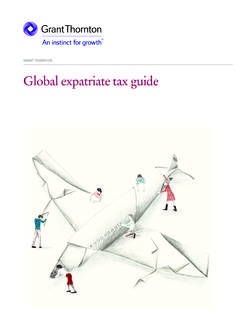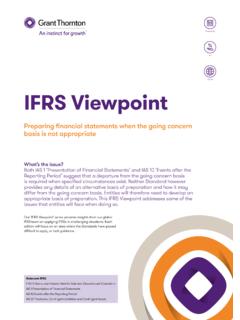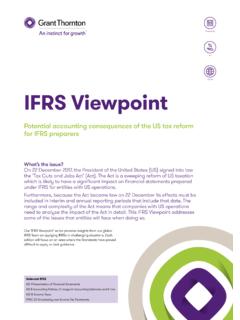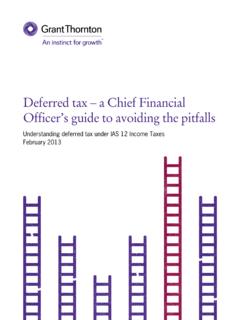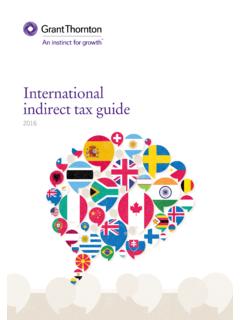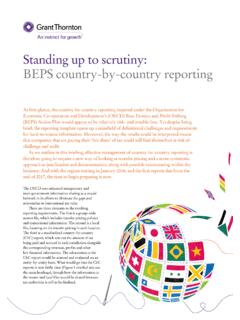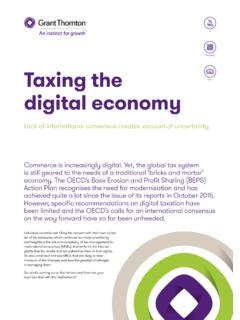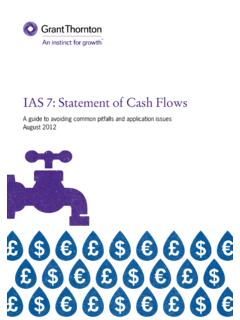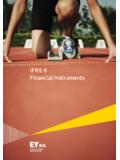Transcription of Get ready for IFRS 9 - Grant Thornton International
1 1010110001101100101101000110110011000100 0010000011000011000010001001001000011111 1100010010001000010001100011000100011010 1100001000100011111101101001001100100010 0011110011001100011010001001001000011111 1100010010001000010001100011000100011010 1010110001101100101101000110110011000100 0010000011000011000011001001010101001100 1010010011101001100110011000110001000110 1010110001101100101101000110110011000100 0010000011000011000011100011000011110001 1001110001110001111000111100001110000111 get ready for ifrs 9 The impairment requirements ifrs 9 (2014) Financial Instruments fundamentally rewrites the accounting rules for financial instruments.
2 It introduces a new approach for financial asset classification; a more forward-looking expected loss model; and major new requirements on hedge accounting. While ifrs 9 s mandatory effective date of 1 January 2018 may seem a long way off, companies really need to start evaluating the impact of the new Standard now. As well as compiling the information necessary to implement the Standard, companies will need to review loan covenants and other agreements that could be affected by the impact on reported results. This is the second in a series of publications designed to get you ready for ifrs 9. In this issue, we bring you up to speed with the Standard s new impairment 2 March 2016101011000110110010110100011011001100 0100001000001100001100001000100100100001 1111110001001000100001000110001100010001 1010110000100010001111110110100100110010 0010001111001100110001101000100100100001 1111110001001000100001000110001100010001 1010101011000110110010110100011011001100 0100001000001100001100001100100101010100 1100101001001110100110011001100011000100 0110101011000110110010110100011011001100 0100001000001100001100001110001100001111 0001100111000111000111100011110000111000 0111 get ready for ifrs 9 Contents1 Introduction 12 Scope of
3 The new impairment requirements 33 The general (or three-stage) impairment approach Overview Impact of a significant increase in credit risk Identifying a significant increase in credit risk Definition of default Interaction with the level of credit risk on initial recognition Interaction with the length to maturity of an instrument Reasonable and supportable information Rebuttable presumption for payments more than 30 days past due Multi-factor analysis Individual or collective assessment Measuring expected credit losses
4 General principles Probability-weighted amount Time value of money Reasonable and supportable information Measurement of expected credit losses for different types of asset/exposure Application issues Period to consider when measuring expected credit losses Collateral Practical expedients Low credit risk exception Other practical expedients 224 Simplified model for trade receivables, contract assets and lease receivables Overview Applying the simplified model 255 Purchased or originated credit-impaired financial assets 286 Presenting credit losses Financial assets measured at amortised cost Financial assets measured at fair value through other comprehensive income 327 Disclosures 348 Practical insight next steps
5 3610101100011011001011010001101100110001 0000100000110000110000100010010010000111 1111000100100010000100011000110001000110 1011000010001000111111011010010011001000 1000111100110011000110100010010010000111 1111000100100010000100011000110001000110 1010101100011011001011010001101100110001 0000100000110000110000110010010101010011 0010100100111010011001100110001100010001 1010101100011011001011010001101100110001 0000100000110000110000111000110000111100 0110011100011100011110001111000011100001 111. IntroductionUnder ifrs 9, recognition of impairment no longer depends on a reporting entity first identifying a credit loss event. This is a major change from the previous Standard, IAS 39.
6 ifrs 9 instead uses more forward-looking information to recognise expected credit losses for all debt-type financial assets that are not measured at fair value through profit or section gives a high level overview of the changes and explains why they were necessary. 1010110001101100101101000110110011000100 0010000011000011000010001001001000011111 1100010010001000010001100011000100011010 1100001000100011111101101001001100100010 0011110011001100011010001001001000011111 1100010010001000010001100011000100011010 1010110001101100101101000110110011000100 0010000011000011000011001001010101001100 1010010011101001100110011000110001000110 1010110001101100101101000110110011000100 0010000011000011000011100011000011110001 1001110001110001111000111100001110000111 Get ready for ifrs 9In July 2014, the IASB issued ifrs 9 s impairment requirements.
7 These fundamentally rewrite the accounting rules for impairment of financial assets. The IASB s aim is to rectify a major perceived weakness in accounting that became evident during the financial crisis of 2007/8, namely that IAS 39 Financial Instruments: Recognition and Measurement resulted in too little, too late too few credit losses being recognised at too late a stage. IAS 39 s incurred loss model delayed the recognition of impairment until objective evidence of a credit loss event had been identified. In addition, IAS 39 was criticised for requiring different measures of impairment for similar assets depending on their classification.
8 ifrs 9 s impairment requirements use more forward-looking information to recognise expected credit losses for all debt-type financial assets that are not measured at fair value through profit or loss (and for some other credit exposures see practical insight box on loan commitments and financial guarantees in section 2). One consequence is that a credit loss arises as soon as a company buys or originates a loan or receivable a so-called day one loss . Unlike IAS 39, the amount of the recognised loss is the same irrespective of whether the asset is measured at amortised cost or at fair value through other comprehensive income.
9 Recognition of impairment therefore no longer depends on the company first identifying a credit loss event. Instead an entity always estimates an expected loss considering a broader range of information, including: past events, such as experience of historical losses for similar financial instruments current conditions reasonable and supportable forecasts that affect the expected collectability of the future cash flows of the financial the following sections we help you evaluate the Standard s requirements, and the challenges that it will Issue 2 March 2016 Recognition of impairment no longer depends on first identifying a credit loss event.
10 Instead all entities will recognise expected credit Scope of the new impairment requirements ifrs 9 s impairment requirements apply to all debt-type assets that are not measured at fair value through profit or loss. Certain other credit exposures that were outside the scope of IAS 39 are also within the scope of the Standard. Investments in equity instruments are outside the scope of the impairment requirements as they are measured at fair value. This section explains the scope of the impairment requirements in more detail and comments on some of the practical implications. Get ready for ifrs 94 Issue 2 March 2016 ifrs 9 (2014) requires an entity to recognise a loss allowance for expected credit losses on: debt instruments measured at amortised cost debt instruments measured at fair value through other comprehensive income lease receivables contract assets (as defined in ifrs 15 Revenue from Contracts with Customers ) loan commitments that are not measured at fair value through profit or loss financial guarantee contracts (except those accounted for as insurance contracts).
